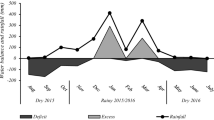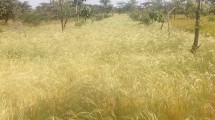Abstract
Agroforestry systems using Eucalyptus for biomass production are important alternatives for small farms in the southeast of Brazil because they integrate timber and food production while reducing the environmental impact of large plantations. In this article, I studied the intercropping of Eucalyptus urophylla with rice and beans for two years to compare yields using intercropping versus monocultures. During the first year, in both seasons (dry and rainy), no differences were found in the productivity between the intercropped and monoculture systems of E. urophylla, rice and beans. In the second year, E. urophylla in monoculture had lower productivity compared to E. urophylla intercropped with agricultural crops. On the other hand, both agriculture crops showed a reduction in the productivity in the intercropping with E. urophylla when compared to monoculture. At least in the first two years, forest biomass production was higher for intercropping systems of E. urophylla with beans and rice compared to monocultural systems.
Resumo
Sistemas agroflorestais utilizando Eucalyptus para a produção de biomassa florestal podem ser considerados como uma alternativa de produção para pequenos produtores no sudeste do Brasil, porque além de integrar a produção de biomassa com a produção de alimentos, reduz o impacto ambiental das plantações em grande escala. Neste trabalho os rendimentos do consorcio de Eucalyptus urophylla com arroz e feijão foram avaliados e comparados com os rendimentos de seus respectivos monocultivos, durante dois anos. No primeiro ano, não foram encontradas diferenças significativas entre os sistemas agroflorestais e os monocultivos de E. urophylla, arroz e feijão em ambas estações (seca e chuvosa). No segundo ano, E. urophylla em monocultivo apresentou uma produtividade mais baixa quando comparada com o E. urophylla consorciado com culturas agrícolas. Por outro lado, as culturas agrícolas consorciadas com E. urophylla apresentaram uma redução na produtividade quando comparados com seus respectivos monocultivos. O modelo do índice de equivalencia de area (IEA) confirmou as vantagens dos sistemas agroflorestais sobre os monocultivos tanto para E. urophylla como para arroz e feijão, ao menos nos dois primeiros anos, quando o principal objetivo é a produção de biomassa florestal.






Similar content being viewed by others
References
ABRAF (2006) Anuário estatístico da ABRAF (Associação Brasileira de Produtores de Florestas Plantadas): ano base 2005. 80 p. Available via: http://www.abraflor.org.br/estatisticas/anuario-ABRAF-2006.pdf. Cited: 22 Mar. 2007
Almeida JCC (1990) Comportamento inicial do Eucalyptus citriodora Hooker, em areas submetidas ao pastejo com bovinos e ovinos no Vale do Rio Doce, Minas Gerais. Universidade Federal de Viçosa, Imprensa Universitaria, Minas Gerais, Brazil
Assis JB, Silva E, Araujo A (1986) Desempenho do reflorestamento em pequenos e médios imóveis na Zona da Mata. Silvicultura 41:50–55
Biblioteca Municipal de Divinópolis (1992) Dados geográficos de Divinópolis. Minas Gerais, Brazil, 4 p
Bedê J, Barezzani P (1991) Projeto empresario agroflorestal - um modelo sustentado. Pains Florestal, Minas Gerais, Brazil, 23 p
Boyer JS (1982) Plant Productivity and environment. Science 218:443–448
Ceccon E (1999) Levantamento do nível tecnológico utilizado por parceiros no plantio de eucalipto de uma empresa reflorestadora na região de Divinópolis Minas Gerais, Brasil. Revista Árvore 23(3):301–310
Ceccon E (2005) Eucalyptus camaldulensis Dehn intercropped with beans (Phaseolus vulgaris L.) and rice (Oryza sativa L.) in Minas Gerais, Brazil: a two years experiment. New Forests 29:261–272
Ceccon E, Martínez-Ramos M (1999) Aspectos ambientales referentes al establecimiento de plantaciones de eucalipto de gran escala en áreas tropicales: aplicación al caso de México. Revista Interciencia 24(5):352–358
Ceccon E, Ramalho MAP, Abreu AFB, Andrade MJB (1999) Consórcio entre Eucalyptus camaldulensis Dehn., aos três anos de idade, e diferentes cultivares de feijão (Phaseolus vulgaris L.). Revista Árvore 23(1):9–14
Cohen Y, Adar E, Dody A, Schiller G (1997) Underground water use by Eucalyptus trees in an arid climate. Trees-Struct Funct 11(6):356–362
Couto L, Betters DR (1995) Short-rotation eucalypt plantations in Brazil: social and environmental issues. Oak Ridge Nat. Laboratory. ORNL/TM-12846. Springfield, US
Couto L, Passos CAM, Ceccon E, Firme DJ (1996) Avaliação da produtividade do consorcio do Eucalyptus urophylla com feijão na região de Divinopolis, In: 4° Simposio Internacional sobre Ecossistemas Florestais., Biosfera. Belo Horizonte, pp: 360–360
Espinosa-Garcia FJ (1996) Review on allelopathy of Eucalyptus L’Herit. Boletin de la Sociedad Botánica de Mexico 58:55–74
Ferreira Neto PS (1993) Comportamento inicial de Eucalyptus grandis W Hill ex maiden em plantio consorciado com leguminosas na Região do Médio Rio Doce, Minas Gerais. Universidade Federal de Viçosa, Imprensa Universitaria, Minas Gerais, Brazil
IBGE (2001) Instituto Brasileiro de Geografia e Estatisca, Governo do Brasil
Larson ED, Rodríguez LCE, Rezende de Azevedo T (1994) Bioresources ‘94 biomass resources: a means to sustainable development. Bangalore, India
Leiva JM (1994) Evaluation of three forest tree species in pure plantation and Taungya system in the upper Achiguate Watershed, Guatemala. University of San Carlos of Guatemala, Faculty of Agronomy, Institute of Agronomical Research, International Foundation for Science, Guatemala
Lima WP (1993) Impacto Ambiental do Eucalipto, 2nd edn. Editora da Universidade de São Paulo, São Paulo
Lisanework N, Michelsen M (1993) Allelopathy in agroforestry systems: the effects of leaf extracts of Cupressus lusitanica and three Eucalyptus spp. on four Ethiopian crops. Agroforest Syst 21:63–74
Lopes da Silva A, Chagas Campos JC, Garcia Leite H, Lopes de Souza A, Falco Lopes P. (2006) Growth and yield prediction using the modified Buckman model. Revista Árvore 30(5):787–793
Magalhães JL (1993) Futuro do carvão vegetal no contexto nacional e internacional. In: Anais. Simpósio Brasileiro de Pesquisa Florestal. Society for Forestry Reasearch, Belo Horizonte, Brazil, pp 59–240
Mora AL (1986) Interação com espacamentos e locais em clones de Eucalyptus spp. no norte do Estado da Bahia. M.Sc. Thesis, Universidade de Sao Paulo - ESALQ, Piracicaba
Neilson D (2000) The global Eucalyptus resource and some solidwood-panel product development issues. In: IUFRO Conference, Launceston, Australia
Nissen TM, Midmore TJ, Cabrera ML (1999) Aboveground and bellow ground competition between intercropped cabbage and young Eucalyptus torelliana. Agroforest Syst 46:83–93
de Oliveira AC, Furtado Ferreira D, Patto Ramalho MA (2000) Experimentação em Genética e Melhoramento de Plantas. Editora Univ. Fed. de Lavras
Ong CK, Corlett JE, Singh RP, Black CR (1991) Above and below ground interactions in agroforestry systems. Forest Ecol Manage 45:45–57
Paleg LG, Aspinall D (eds) (1981) Physiology and biochemistry of drought resistance in plants. Academic Press, Australia
Passos CAM (1996) Sistemas agroflorestais com eucalipto para uso em programas de fomento florestal, na região de Divinópolis, Minas Gerais. DSc, Universidade Federal de Viçosa, Viçosa, Brazil
Pereira RC, Davide LC, Patto Ramalho MA, Andrade HB (2002) Alternativas para aumentar a eficiência dos cruzamentos em programas de melhoramento de Eucalyptus. CERNE 8(2):60–69
Pinkard EA, Battaglia M, Beadle CL, Sands PJ (1999). Modeling the effect of physiological responses to green pruning on net biomass production of Eucalyptus nitens. Tree Physiol 19(1):1–12
Pinto LFG, Bernardes MS, Stape JL, Pereira AR (2005) Growth, yield and system performance simulation of a sugarcane-eucalyptus interface in a sub-tropical region of Brazil. Agric Ecosyst Environ 105(1–2):77–86
Santana RC, Barros NF, Comerford NB (2000) Above-ground biomass, nutrient content, and nutrient use efficiency of eucalypt plantations growing in different sites in Brazil. N Z J For Sci 30:225–236
Scanavaca Junior L, García JN (2003) Potencial de melhoramento genetico en E. urophylla procedente de Ilha Flores. Scientia Forestalis 64:23–32
Schreiner HG, Balloni EA (1986) Consórcio de culturas de feijão (Phaseolus vulgaris) e eucalipto (Eucalyptus grandis W Hill ex Maiden) no sudeste do Brasil. EMBRAPA, Bol Pesqui Florestal 12:83–104
Schlönvoigt A, Beer J (2001) Initial growth of pioneer timber tree species in a Taungya system in the humid lowlands of Costa Rica. Agroforest Syst 51(2):97–108
Singh D, Kohly RK (1992) Impact of Eucalyptus terenticornis Sm. shelterbelts on crops. Agroforest Syst 20:253–266
Stape JL, Martini EL (1992) Plantio consorciado de Eucalyptus e arroz na região de Itararé–SP, In: Anais. vol I. 2o Encontro Brasileiro de Economia e Planejamento Florestal – Sistemas Agroflorestais no Brasil: Aspectos Técnicos e econômicos, EMBRAPA, Brazil, pp 155–169
Stape JL, Gonçalves JLM, Gonçalves AN (2001) Relationships between nursery practices and field performance for Eucalyptus plantations in Brazil: a historical overview and its increasing importance. New Forests 22:19–41
Sungsumarn K (1993) Why is eucalypt not adopted for agroforestry? In: Proceedings of the regional expert consultation on Eucalyptus. FAO Regional Office for Asia and the Pacific, Bangkok, 194 p
Roy J, Mooney HA, Saugier B (2001) Terrestrial global productivity. Academic Press, San Diego
da Veiga JE (1996) Agricultura Familiar e Sustentabilidade. Cadernos de Ciência e Tecnologia EMBRAPA 13(3):383–404
Vertessy RA, Benyon RG, O’Sullivan SK, Gribben PR (1995.) Relationships between stem diameter, sapwood area, leaf area and transpiration in a young mountain ash forest. Tree Physiol 15(9):559–567
Willey RW, Osiru RJO (1972) Studies on mixture maize and beans with particular reference to plant population. J Agric Sci, New York 79:516–529
Acknowledgements
I gratefully acknowledge PAINS Florestal S. A. (Brazil) for financial support and Deuselis João Firme, Julio Bedê and Luciano Rodrigues for their valuable suggestions provided during this study. We also thank Adinésio for assistance in the field and to Dr. Octavio Miramontes, Dr. Todd S. Fredericksen and Angie Kitson-Harris for English revision and suggestions to the manuscript.
Author information
Authors and Affiliations
Corresponding author
Rights and permissions
About this article
Cite this article
Ceccon, E. Production of bioenergy on small farms: a two-year agroforestry experiment using Eucalyptus urophylla intercropped with rice and beans in Minas Gerais, Brazil. New Forests 35, 285–298 (2008). https://doi.org/10.1007/s11056-007-9077-0
Received:
Accepted:
Published:
Issue Date:
DOI: https://doi.org/10.1007/s11056-007-9077-0
Keywords
- Agriculture crops
- Land equivalent ratio
- Agroforestry systems
- Monoculture
- Intercropping
- Forest partnership




